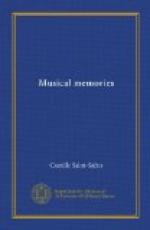Meyerbeer ventured to use combinations in harmony which were considered rash at that time. They pretend that the sensitiveness of the ear has been developed since then, but in reality it has been dulled by having to undergo the most violent discords.
The beautiful “progression” of the exorcism in the fourth act of Le Prophete was not accepted without some difficulty. I can still see Gounod seated at a piano singing the debated passage and trying to convince a group of recalcitrant listeners of its beauty.
Meyerbeer developed the role of the English horn, which up to that time had been used only rarely and timidly, and he also introduced the bass clarinet into the orchestra. But the two instruments, as he used them, still appeared somewhat unusual. They were objects of luxury, strangers of distinction which one saluted respectfully and which played no great part. Under Wagner’s management they became a definite part of the household and, as we know, brought in a wealth of coloring.
It is an open question whether it was Meyerbeer or Scribe who planned the amazing stage setting in the cathedral scene in Le Prophete. It must have been Meyerbeer, for Scribe was not temperamentally a revolutionist, and this scene was really revolutionary. The brilliant procession with its crowd of performers which goes across the stage through the nave into the choir, constantly keeping its distance from the audience, is an impressive, realistic and beautiful scene. But directors who go to great expense for the costumes cannot understand why the procession should file anywhere except before the footlights as near the audience as possible, and it is extremely difficult to get any other method of procedure.
Furthermore, the amusing idea of the skating ballet was due to Meyerbeer. At the time there was an amusing fellow in Paris who had invented roller skates and who used to practise his favorite sport on fine evenings on the large concrete surfaces of the Place de la Concorde. Meyerbeer saw him and got the idea of the famous ballet. In the early days of the opera it certainly was charming to see the skaters come on accompanied by a pretty chorus and a rhythm from the violins regulated by that of the dancers. But the performance began at seven and ended at midnight. Now they begin at eight and to gain the hour they had to accelerate the pace. So the chorus in question was sacrificed. That was bad for Les Huguenots. The author tried to make a good deal out of the last act with its beautiful choruses in the church—a development of the Luther chant—and the terror of the approaching massacre. But this act has been cut, mutilated and made generally unrecognizable. They even go so far in some of the foreign houses as to suppress it entirely.




